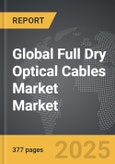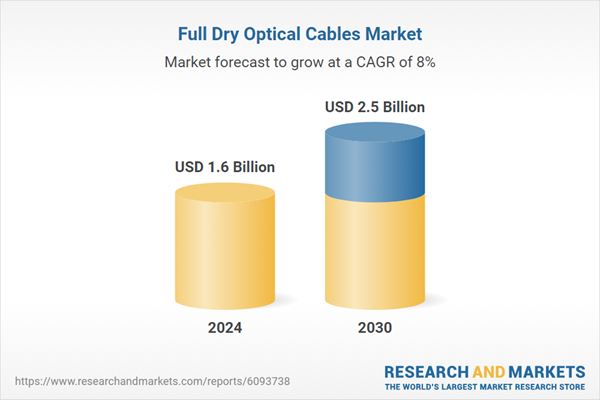Global Full Dry Optical Cables Market - Key Trends & Drivers Summarized
Why Are Full Dry Optical Cables Revolutionizing Fiber Optic Network Infrastructure?
Full dry optical cables are transforming the fiber optic cable industry by offering a cleaner, more efficient, and environmentally friendly alternative to traditional gel-filled designs. These cables eliminate the need for messy gel compounds, which were historically used for water blocking and protection against moisture ingress. Instead, full dry cables utilize water-blocking tapes and powders that rapidly swell to seal off any water intrusion, ensuring reliable signal transmission while significantly reducing installation time and labor. Their dry construction results in a lighter weight, easier handling, and simplified splicing and connectorization, which are crucial advantages in large-scale deployments like long-haul, metro, and access fiber networks. The absence of gel also minimizes the need for additional cleaning during installation and maintenance, reducing waste and technician fatigue. This streamlined deployment process aligns well with the needs of telecom providers and data center operators who are under pressure to roll out high-speed fiber networks quickly and cost-effectively. Additionally, the environmental and operational benefits of full dry cables - such as lower carbon emissions during transportation due to reduced weight and simplified recycling at end-of-life - further underscore their role in sustainable infrastructure development. As demand for faster internet, 5G connectivity, and high-capacity backhaul grows globally, full dry optical cables are becoming an essential component in next-generation broadband infrastructure.How Are End-Use Applications Expanding the Scope of Full Dry Optical Cables?
The versatility and performance benefits of full dry optical cables are driving their adoption across a wide array of end-use applications, well beyond traditional telecom networks. In the telecommunications sector, they are being widely deployed in fiber-to-the-home (FTTH), fiber-to-the-building (FTTB), and fiber-to-the-antenna (FTTA) setups where high data rates and quick, clean installations are critical. As 5G networks demand higher bandwidth and more robust backhaul solutions, full dry cables are being integrated into urban and suburban infrastructure for both aerial and underground routing. In data center interconnects, where space constraints and cable density present constant challenges, their lightweight and manageable design improves airflow and facilitates easier cable management. Utilities and smart grid operators are also turning to full dry optical cables for telemetry and control networks, especially in overhead power line and duct installations where environmental exposure is high. Railways and transportation systems use these cables for signal transmission and surveillance infrastructure, benefiting from their resilience to vibration and harsh weather. Military and aerospace applications favor full dry constructions due to their clean handling and robust mechanical performance in tactical and mobile communication units. Furthermore, as smart cities and IoT ecosystems expand, municipalities are laying full dry cables to support traffic systems, security monitoring, and public Wi-Fi access points. The breadth of these applications highlights how full dry optical cables are meeting the evolving connectivity needs of an increasingly digitized and bandwidth-intensive world.What Technological Innovations Are Enhancing the Performance and Reliability of Full Dry Optical Cables?
Continuous innovation in materials science, cable architecture, and manufacturing processes is significantly boosting the performance and reliability of full dry optical cables. One major area of advancement is the development of highly absorbent and fast-acting water-blocking powders and tapes that ensure instant swelling upon moisture exposure, effectively preventing water migration and preserving signal integrity. These materials are being engineered to remain stable across a wide range of temperatures, humidity levels, and mechanical stresses, enhancing the suitability of full dry cables for diverse environmental conditions. The use of bend-insensitive optical fibers in full dry designs is further reducing signal attenuation in tight bends and dense installations, which is especially valuable in urban deployments and cramped utility ducts. Innovations in sheath materials - such as UV-resistant and rodent-resistant coatings - are extending the service life of cables in challenging outdoor environments. Additionally, manufacturers are incorporating color-coded fiber bundles, easy-access designs, and dry-access technology to streamline identification, mid-span entry, and field splicing. Precision manufacturing techniques are ensuring consistent core alignment and cable concentricity, improving mechanical robustness and minimizing micro-bending losses. Some suppliers are also integrating real-time cable performance monitoring features into full dry cables, providing diagnostics for early fault detection and predictive maintenance. These technological advancements are reinforcing the reputation of full dry optical cables as a high-performance, future-ready solution in the global fiber optic marketplace.What Market Forces Are Fueling the Global Growth of Full Dry Optical Cables?
The growth of the full dry optical cables market is being driven by several converging global forces, including the rapid expansion of digital infrastructure, environmental regulations, cost efficiency imperatives, and evolving network architecture demands. One of the most significant drivers is the accelerating rollout of high-speed broadband, 5G networks, and fiber-based connectivity in both urban and rural areas, which necessitates scalable and easy-to-install cabling solutions. Government-funded digital inclusion initiatives and smart city projects across Asia-Pacific, Europe, and North America are further bolstering demand for full dry cables due to their time-saving installation benefits and low total cost of ownership. Additionally, the rising awareness of environmental impact is leading operators to favor dry, gel-free cables that generate less waste and are easier to recycle. The global fiber optic supply chain is also adapting to labor shortages and rising wages by emphasizing products that simplify field work - another advantage offered by full dry designs. Meanwhile, the migration toward centralized and virtualized network architectures (e.g., cloud RAN and edge computing) is increasing the density and complexity of fiber installations, requiring cables that are both high-performance and easy to manage. Competitive pressure among telecom providers to offer higher bandwidth at lower operational costs is further reinforcing the market shift toward full dry solutions. With a growing number of stakeholders recognizing their practical, environmental, and economic advantages, full dry optical cables are poised for sustained global expansion as a cornerstone of 21st-century connectivity infrastructure.Report Scope
The report analyzes the Full Dry Optical Cables market, presented in terms of market value (US$). The analysis covers the key segments and geographic regions outlined below:- Segments: Type (Single-Mode, Multi-Mode); Product Type (Skeleton, Stranded); End-Use (Telecommunications, Healthcare, Data Centers, Military, Other End-Uses).
- Geographic Regions/Countries: World; United States; Canada; Japan; China; Europe (France; Germany; Italy; United Kingdom; Spain; Russia; and Rest of Europe); Asia-Pacific (Australia; India; South Korea; and Rest of Asia-Pacific); Latin America (Argentina; Brazil; Mexico; and Rest of Latin America); Middle East (Iran; Israel; Saudi Arabia; United Arab Emirates; and Rest of Middle East); and Africa.
Key Insights:
- Market Growth: Understand the significant growth trajectory of the Single-Mode Cables segment, which is expected to reach US$1.8 Billion by 2030 with a CAGR of a 9.2%. The Multi-Mode Cables segment is also set to grow at 5.5% CAGR over the analysis period.
- Regional Analysis: Gain insights into the U.S. market, valued at $427.9 Million in 2024, and China, forecasted to grow at an impressive 12.7% CAGR to reach $541.9 Million by 2030. Discover growth trends in other key regions, including Japan, Canada, Germany, and the Asia-Pacific.
Why You Should Buy This Report:
- Detailed Market Analysis: Access a thorough analysis of the Global Full Dry Optical Cables Market, covering all major geographic regions and market segments.
- Competitive Insights: Get an overview of the competitive landscape, including the market presence of major players across different geographies.
- Future Trends and Drivers: Understand the key trends and drivers shaping the future of the Global Full Dry Optical Cables Market.
- Actionable Insights: Benefit from actionable insights that can help you identify new revenue opportunities and make strategic business decisions.
Key Questions Answered:
- How is the Global Full Dry Optical Cables Market expected to evolve by 2030?
- What are the main drivers and restraints affecting the market?
- Which market segments will grow the most over the forecast period?
- How will market shares for different regions and segments change by 2030?
- Who are the leading players in the market, and what are their prospects?
Report Features:
- Comprehensive Market Data: Independent analysis of annual sales and market forecasts in US$ Million from 2024 to 2030.
- In-Depth Regional Analysis: Detailed insights into key markets, including the U.S., China, Japan, Canada, Europe, Asia-Pacific, Latin America, Middle East, and Africa.
- Company Profiles: Coverage of players such as Apple Inc., AU Optronics Corp., BOE Technology Group Co., Ltd., C SEED Entertainment Systems, eLux, Inc. and more.
- Complimentary Updates: Receive free report updates for one year to keep you informed of the latest market developments.
Some of the 44 companies featured in this Full Dry Optical Cables market report include:
- AFL Global
- Belden Inc.
- CommScope
- Corning Incorporated
- Crxconec Company Ltd.
- Fiber Savvy
- FiberHome Telecommunication Technologies
- Fujikura Ltd.
- Furukawa Electric Co., Ltd.
- Hengtong Optic-Electric Co., Ltd.
- Jiangsu Zhongtian Technology Co., Ltd.
- LS Cable & System Ltd.
- OFS Fitel, LLC
- Panduit Corp.
- Prysmian Group
- SAMM Teknoloji
- Sterlite Technologies Ltd.
- Sumitomo Electric Industries, Ltd.
- Taihan Fiberoptics Co., Ltd.
- Yangtze Optical Fibre and Cable Joint Stock Limited Company (YOFC)
This edition integrates the latest global trade and economic shifts into comprehensive market analysis. Key updates include:
- Tariff and Trade Impact: Insights into global tariff negotiations across 180+ countries, with analysis of supply chain turbulence, sourcing disruptions, and geographic realignment. Special focus on 2025 as a pivotal year for trade tensions, including updated perspectives on the Trump-era tariffs.
- Adjusted Forecasts and Analytics: Revised global and regional market forecasts through 2030, incorporating tariff effects, economic uncertainty, and structural changes in globalization. Includes historical analysis from 2015 to 2023.
- Strategic Market Dynamics: Evaluation of revised market prospects, regional outlooks, and key economic indicators such as population and urbanization trends.
- Innovation & Technology Trends: Latest developments in product and process innovation, emerging technologies, and key industry drivers shaping the competitive landscape.
- Competitive Intelligence: Updated global market share estimates for 2025, competitive positioning of major players (Strong/Active/Niche/Trivial), and refined focus on leading global brands and core players.
- Expert Insight & Commentary: Strategic analysis from economists, trade experts, and domain specialists to contextualize market shifts and identify emerging opportunities.
Table of Contents
Companies Mentioned (Partial List)
A selection of companies mentioned in this report includes, but is not limited to:
- AFL Global
- Belden Inc.
- CommScope
- Corning Incorporated
- Crxconec Company Ltd.
- Fiber Savvy
- FiberHome Telecommunication Technologies
- Fujikura Ltd.
- Furukawa Electric Co., Ltd.
- Hengtong Optic-Electric Co., Ltd.
- Jiangsu Zhongtian Technology Co., Ltd.
- LS Cable & System Ltd.
- OFS Fitel, LLC
- Panduit Corp.
- Prysmian Group
- SAMM Teknoloji
- Sterlite Technologies Ltd.
- Sumitomo Electric Industries, Ltd.
- Taihan Fiberoptics Co., Ltd.
- Yangtze Optical Fibre and Cable Joint Stock Limited Company (YOFC)
Table Information
| Report Attribute | Details |
|---|---|
| No. of Pages | 377 |
| Published | December 2025 |
| Forecast Period | 2024 - 2030 |
| Estimated Market Value ( USD | $ 1.6 Billion |
| Forecasted Market Value ( USD | $ 2.5 Billion |
| Compound Annual Growth Rate | 8.0% |
| Regions Covered | Global |









